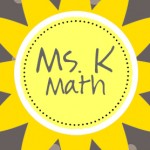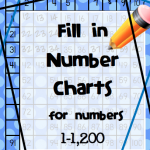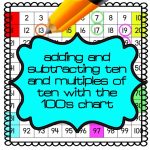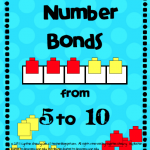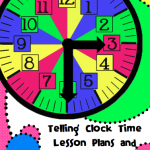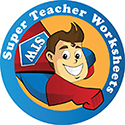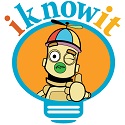My New Singapore Math Manipulatives!
I get the luxury of ordering new math materials for my school. To prepare for all of the common core instruction in place value, fractions, and decimals, I ordered lots of fraction circles, some more unifix cubes, and some place value strips. When my order came in this week, it was like Christmas! That is always the feeling I have anytime I rip open boxes of new math materials! I am most excited about the place value strips which are pictured below. As you can see in the pictures, they come apart so that students actually see the value of the number. These are one of the Singapore Math manipulatives. Each color matches the Singapore math discs if you decide to get those as well which I use with 1st, 2nd, and 3rd grade. If you want to have a smaller size, there is also a copy, cut and laminate version in one of Sandra Chen’s books, The Parent Connection for Singapore Math.
Free Test Taking Rubric or Checklist
I showed the fifth graders that I have been teaching for the past few weeks this page before they tested. I let them know that I was going to be looking for these actions or test taking strategies while they tested. Our principal gave the students extra recess time at the end of the day if they worked hard on the test all morning long. I wanted a way to measure “working hard on the test”, so I used this checklist/rubric. If students did 4 of the 6 actions or testing strategies listed on the sheet, then they were able to have extra recess. Across the top of the page the categories read:
- Underlined Key Words
- Brain Dumped— Writing important information down on the math reference sheet that they may forget
- Eliminated Wrong Answers (on multiple choice)
- Used P.E.C.E (an acronym that stands for using a picture, equation, complete sentence, and elaboration to solve an open response)
- Persevered When Problem Solving
- Checked Work or Used the Entire Time to Work
If you would like to use this form, you can download it for free here. I am posting it in Word format so that you can open it and change the wording to suit your needs.
Do You Need a Fun Way for Students to Experience Perimeter, Area, or Volume?
Students built the following houses out of food items and then calculated the perimeter of them. We did this project as a relaxing activity after testing. I allowed students to build houses out of graham crackers, frosting, red hots, marshmallows, and Smarties. Then they used a measurement tool to calculate the perimeter in centimeters. If I had really wanted to use this activity to stimulate mathematical thinking, I would have had the students calculate the surface area and the volume using large marshmallows. Since I just wanted the kids to take a fun break after testing, I didn’t have them calculate anything except the perimeter. If I had to pick their favorite after testing activity from this week, this would have to be it!

One of the most creative houses the kids built. If you look on the napkin, you can see the perimeter calculations.
How Can You Use Pattern Blocks to Simplify Fractions?
Use pattern blocks to help students find equivalent fractions. Students simply take the blocks and trade them in for larger and larger blocks until they can not use any larger blocks to make the same shape. See below for some examples. The first row shows the blocks as fractions of 1 hexagon.
To make using hexagons for fractions more engaging, call them cookies since they are yellow and the size of a cookie. There is a TERC math investigation lesson called “Hexagon Cookies” which is in the Fair Shares book (for 3rd grade). Hexagon Cookies makes a great lesson to teach previous to simplifying fractions with the pattern blocks.
Fabulous App Find!!
I just discovered a new app called Show Me similar to an interactive white board on the ipad. A kindergarten teacher shared with me today how she uses this app in her classroom. She uses a class set of ipads and has the students record themselves talking as they are solving math problems. The app has the ability to record the students’ voices and actions on the screen as they are thinking through their problem. Students can write on the screen with their finger or a stylus in several different colors while they are solving their problem. Pictures can be imported from the ipad files or you could email yourself a picture from another file to have it on your ipad. For example, if you wanted to solve problems with color tiles, then you could build some colored squares in another program and email them to yourself. This particular kindergarten teacher, however, explained how she had students solve CGI problem types on the ipad while they recorded their voice and writing on the screen. She did this in order that she could hear their thinking because she wasn’t always able to make it to every student to hear their thinking. Later she would take the ipad home so she could hear the students solving their problems.
A Simple, Quick Activity to Make Area, Perimeter, and Volume “Click” with Kids
Every year the same thing happens. Students get area, perimeter, and volume confused. Several years ago I went to an NCTM conference and a presenter there suggested this activity. I kind of made it my own since I have been teaching fifth grade a lot lately. She suggested taking index cards and labeling them “AREA” and “PERIMETER”. I added “VOLUME” also. Then read aloud several statements and have students hold up the card so that all including you can see. I had a list of about fifteen statements such as:
- How much sand to fill up a sandbox?
- How far is the distance around the playground?
- How much bulletin board border do you need to go around the bulletin board?
- How much paint do we need to cover the classroom wall?
- How much fabric do you need to make a tablecloth to cover the table?
- How much water is needed to fill a swimming pool?
- How much carpet do I need to buy to make a comfortable reading center?

We did this orally in class for about fifteen minutes and after each statement, I asked the student why the answer was what they held up on his or her card. Sometimes instead of asking why the answer is perimeter, I asked why is the answer not area or volume. At first when we did this activity students had mixed answers and I could tell that they didn’t have an understanding of these terms. After spending a while explaining why or why not an answer was correct, I noticed that most of the students were correct as they held up their cards. I had thought of giving the students three different colored cards so that I could easily tell which word they were holding up, and then I changed my mind. I decided that if I could quickly tell which card that students were holding up, then other students would simply look at the color of the “smart” kids’ cards and not do much of their own thinking.
To extend this activity, I had students keep their cards in their notebooks and add to them the next day. On the back of the perimeter card, students wrote “UNITS”. On the back of the area card, students wrote ” SQUARE UNITS”, and on the back of the volume card, students wrote “CUBIC UNITS”. I used the same fifteen statements and had the students hold up the cards just as before, but this time with the units side facing me. Doing this helped them see the connection between perimeter, area, and volume with which type of units each measured.
After these activities most students were holding up the correct card and had the general understanding that:
- perimeter and units measure distance
- area and square units cover
- volume and cubic units fill.
This activity could be used in other disciplines as well if students are struggling with the meaning of a few terms. The beauty of this is you as a teacher have an immediate quick assessment for students who aren’t understanding as soon as you see their card.
Nothing But Nets!
Here is a little something I have been working on–Nothing But Nets. I recently posted this on TPT. I used this to teach a fifth grade class about what nets worked to build a cube without overlapping. Before I used this lesson, I gave students some grid paper and asked them to find as many ways as they could to build a net for one cubic unit. Then we posted all of the nets–ones that worked and ones that didn’t on a chart. We grouped the nets into two sections so we could see the similar characteristics that made a net work or not work. We gathered on the carpet for an up close look at the similarities among the nets. Students made some good generalizations about what would make a net work such as the net must have 6 squares and be flexible enough to surround the cube. Students also made generalizations about cubes that didn’t work. Among students comments were these generalizations–they noticed nets that don’t work may have more or less than 6 faces and have squares clumped together.
After students had made these generalizations about nets, I gave them this activity for them to test their generalizations. Students were given a series of 10 nets. They predicted which would and wouldn’t work. Then they were allowed to cut them out to test their predictions. We grouped the nets again into categories that worked and that didn’t work. Students began to notice more characteristics about the nets which made them work or not work. After these two lessons, students did very well on their nets quiz. Below is the nets activity I used which is available at TPT.
Happy Spring Break to ALL Who Celebrate!
Today marks the first day of my spring break. I have no exciting travel plans. I suppose I will have to live vicariously through someone else’s beach getaway. I will be spending time with my furry friend, gardening, spring cleaning, catching up with friends, adding to my blog and completing some materials for TPT. I may even refinish a piece of furniture somewhere in there. I have been looking forward to working in my yard, and since I live in the south, it has already been VERY beautiful outside–reaching a balmy 83 today :). So staying at home will almost be like the beach!
Other updates since I haven’t posted in a while: I have been selected to attend a series of math common core meetings which are led by Linda Griffith. Linda Griffith has had experience working with researchers such as Constance Kami (one of the constructivist researchers I learned about in college). She is an excellent professor who works at a state teachers college here. She is funny, practical, and extremely smart. I have learned so much from her! The teachers and coaches who were selected to attend these meetings are responsible for training others in the district about common core math standards. I will be eventually sharing what I have learned in pieces on my blog. I will have to say that attending her meetings have sparked a passion in me again to teach mathematicians and NOT test takers! I am sure many of you share the same divided feelings that I do when teaching. You want to teach the child to mastery of a skill and ask probing questions to lead students there, however you have to COVER the material. And so we sacrifice mastery for covering material. Then when kids don’t score well, we scratch our heads and say, “Well, I covered it?” Now, the common core standards will allow us to teach to mastery and let students learning and understanding guide our lessons instead of our need to COVER material.
Oh, and Happy St. Patrick’s Day to you all!
Teacher Discounts Galore!!
So many discounts,, I don’t know what to do. I just stumbled upon this website, which has way more discounts than I ever knew existed for teachers. The website states that the more people that join, the better the offers that they can negotiate for teachers. I am signing up right now! Check the site out at http://myeducationdiscount.com/.
